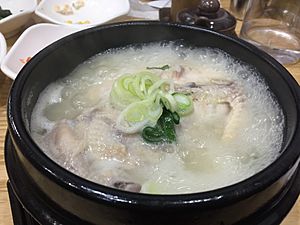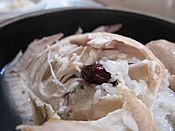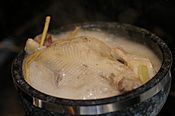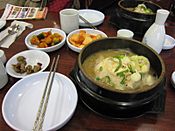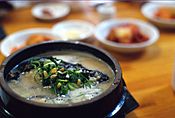Samgye-tang facts for kids
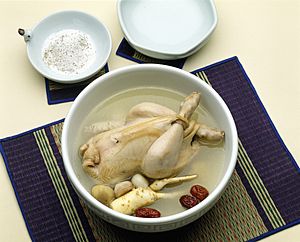 |
|
| Alternative names | Ginseng chicken soup |
|---|---|
| Type | Tang |
| Place of origin | Korea |
| Serving temperature | Hot or Warm |
| Main ingredients | Chicken, ginseng |
| Ingredients generally used | Jujube, glutinous rice |
| Korean name | |
| Hangul |
삼계탕
|
|---|---|
| Hanja |
蔘鷄湯
|
| Revised Romanization | samgye-tang |
| McCune–Reischauer | samgye-t'ang |
| IPA | [sam.ɡje̞.tʰaŋ] |
Samgye-tang (삼계탕; 蔘鷄湯) is a famous Korean soup. It is also known as ginseng chicken soup. The name comes from Korean words: sam (ginseng), gye (chicken), and tang (soup).
This special soup is made with a whole young chicken. Inside the chicken, you'll find ingredients like garlic, rice, jujube (a type of date), and ginseng. Samgye-tang is a traditional Korean dish known for being very healthy. People often eat it in the summer to help their bodies stay strong.
Contents
A Look Back: The History of Samgye-tang
People in ancient Korea (from 1392 to 1897) enjoyed many chicken soups. These soups were similar to the Samgye-tang we know today. They had names like Yeongye-tang and Chonggye-tang.
It was a tradition to make soup with young chickens for older family members in summer. There's a story about a chicken soup with milkvetch roots. This soup was given to a sick queen during the time of King Injo.
The first clear description of a dish like modern Samgye-tang appeared in a cookbook from 1917. This book, called Joseon Yorijaebeop, explained how to make "Dakguk" (chicken soup). It said to stuff a chicken with glutinous rice and ginseng powder. Then, you would tie it up and boil it in water.
During the time when Japan ruled Korea, officials noticed something interesting. Rich families would boil chickens stuffed with ginseng. They used the broth as medicine during the hot summer months.
Samgye-tang started being sold in restaurants around the 1940s. In the 1950s, it was called Gyesam-tang, which means "chicken ginseng soup." Back then, ginseng was often used as a powder.
Later, around the 1960s, refrigerators became common in Korea. This made it possible to keep whole pieces of ginseng fresh. So, people started stuffing chickens with whole ginseng instead of powder. This is how the dish became what it is today. To show how important ginseng was, people began calling it Samgye-tang ("ginseng chicken soup"). This name put ginseng first.
Why Koreans Love Samgye-tang
It's a common tradition in Korea to eat Samgye-tang on hot summer days. People believe it helps them get back the energy and nutrients they lose from sweating. It's especially popular to eat this soup on three specific summer days.
These days are called sambok (삼복). They are Chobok, Jungbok, and Malbok. These three days are usually the hottest and most humid days of the Korean summer. Eating hot soup might seem strange on a hot day. But many Koreans believe it helps cool their bodies down from the inside.
Some restaurants in South Korea specialize only in Samgye-tang. They become very popular because of their unique, secret recipes. Sometimes, these restaurants even give you a small bottle of insam-ju (ginseng wine) with your meal.
How to Make Samgye-tang
Making Samgye-tang involves a few simple steps. First, you take a whole chicken that has been cleaned. Then, you fill its stomach with glutinous rice, garlic, and jujube. These ingredients are often wrapped in a clean cloth.
Next, you place the stuffed chicken in a large pot. You add plenty of water and boil it until the chicken is fully cooked and tender. Ginseng is also added to the soup. It can be wrapped in a cloth too, so its healthy ingredients mix into the broth.
You can season the soup with salt to taste. Some people only drink the soup, while others eat the chicken meat too. Some people think you shouldn't eat the jujubes because they might absorb bad things. But this is not true, and you can enjoy them!
It's best to use a young chicken and ginseng that is about six years old for Samgye-tang. However, these ingredients can be expensive or hard to find. So, many restaurants might use slightly different chickens or ginseng that is four years old. Experts say that four-year-old ginseng is still very good. It has similar amounts of saponin, which is the healthy part of ginseng. Some companies even use younger ginseng or a plant called Astragalus propinquus because it tastes similar.
Gallery
-
Samgyetang with kimchi and insam-ju (ginseng wine)
See also
 In Spanish: Samgyetang para niños
In Spanish: Samgyetang para niños


